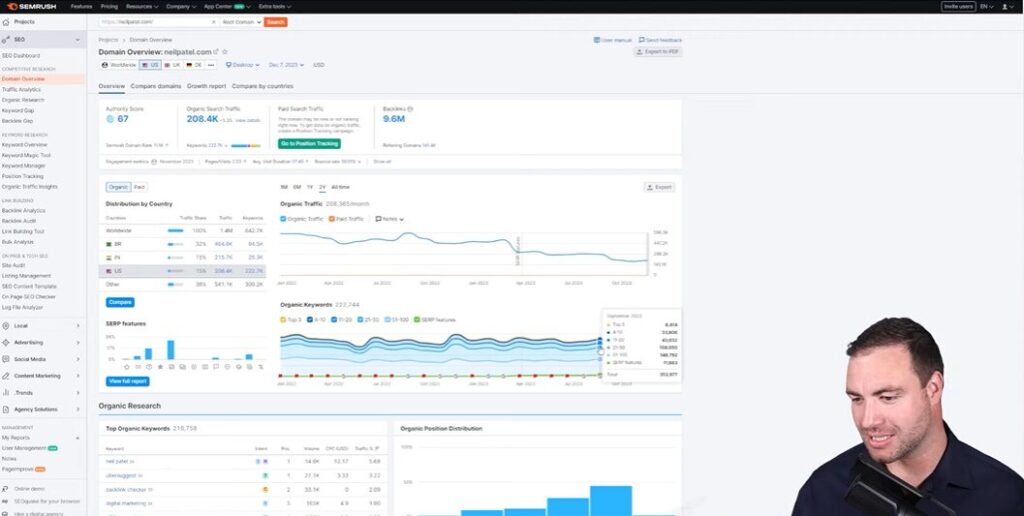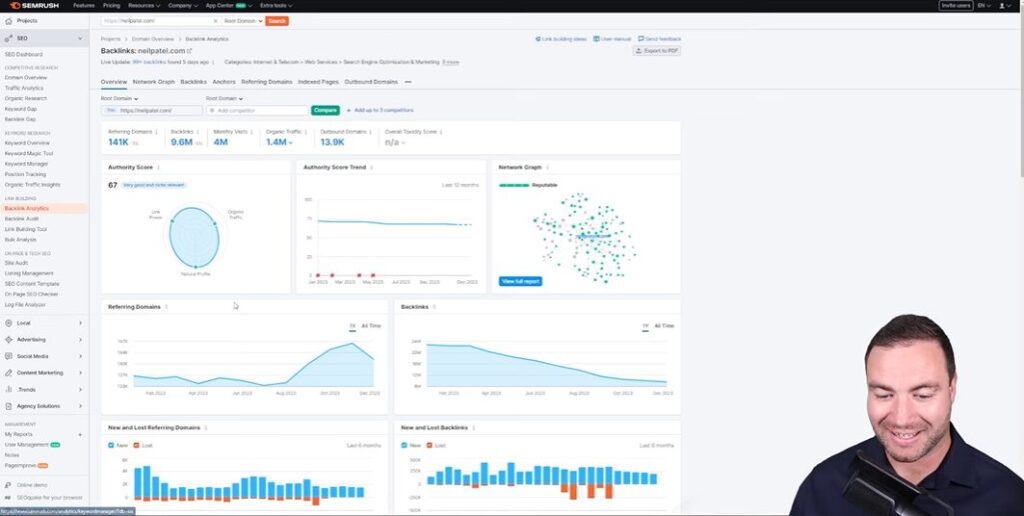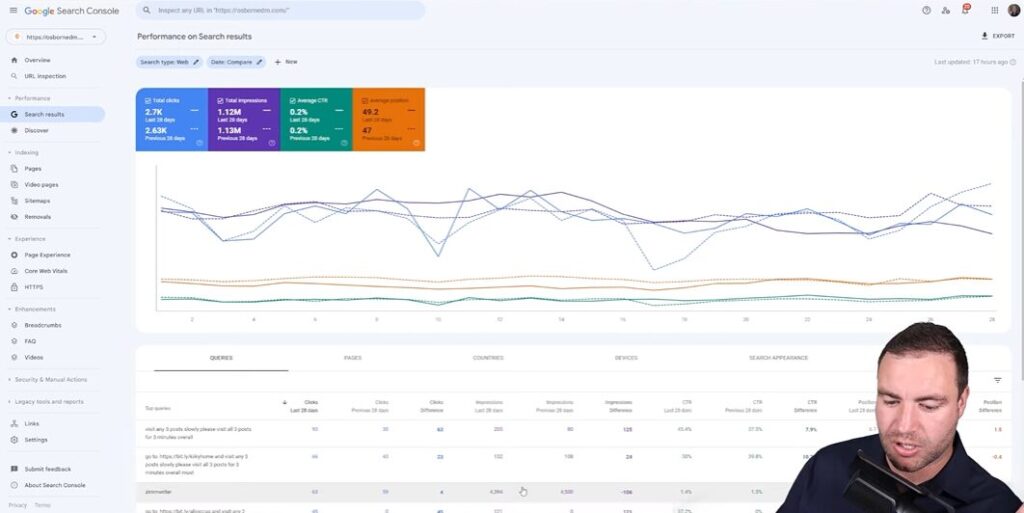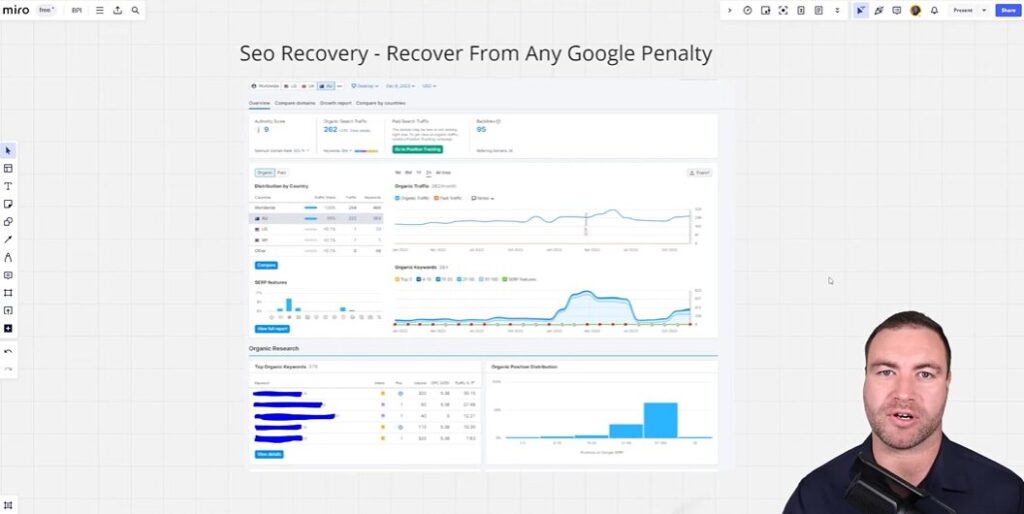Hey there! Ron from Osborne Digital Marketing here. Let me kick things off with a little story. Picture this: a thriving chiropractic clinic, busy with new patients, suddenly faces a zero-patient month after they dived headfirst into AI-generated content. Panic sets in, and that’s where I swoop in to help turn the tide. Join me as I share how we navigated the stormy waters of SEO recovery and recover from any Google penalty effectively.
TL;DR: Recovering from a Google penalty is challenging, but actionable steps like keyword analysis, backlink review, and content evaluation can turn your ranking around. Follow my case study for insights and strategies!
Table of Contents
Understanding Google Penalties: The Setup
What Is A Google Penalty
A Google penalty is a punishment imposed on a website for violating Google's Webmaster Guidelines. This can occur due to various reasons, such as deploying black hat SEO tactics or having poor-quality content. When a site is penalized, its rankings drop significantly. Sometimes, it can even disappear from search results altogether. Can you imagine pouring your heart into your website only to find it can't be found? That’s the harsh reality of a Google penalty.
Different Types Of Penalties And Their Impacts
There are two major types of penalties - algorithmic and manual.
- Algorithmic penalties: These happen automatically when Google updates its search algorithms. For instance, changes like the Panda update affected sites with low-quality content. If your site was seen as less valuable, you could be hit without even knowing it.
- Manual penalties: These occur when a Google reviewer assesses your website and flags it for specific violations. This can result in direct actions against your site - poor rankings or complete removal from search results.
The impact? Businesses can face serious consequences, such as a reduced number of visitors and dwindling sales.
Signs Your Site Might Be Penalized
How can you tell if your site is in trouble? Here are a few signs:
- Your site traffic drops dramatically.
- You notice a sudden loss of keyword rankings.
- Your site disappears from search engine results.
- Unexplained drops in conversion rates.
These indicators can be alarming. If you spot any, it’s time to investigate.
Real-life Example Of A Chiropractor Facing A Penalty
Let me share a story. One of my clients was a chiropractic clinic trying to boost their online visibility. They used AI-generated content from ChatGPT, thinking it would attract more clients. Initially, they saw success - new patients were pouring in. However, that joy was short-lived. They experienced a shocking drop in patient acquisitions: they went an entire month without a single new patient!
The clinic was employing four chiropractors, so you can imagine the panic. My focus was not just on traffic; rather, it was about revenue generation. After several months of recovery efforts, we managed to bring in 23 new patients. That's the power of understanding Google penalties!
Review Decreased Ranking Keywords In SEM Rush

When it comes to SEO, one of the most disheartening experiences is watching your keywords drop in rankings. I remember when the chiropractic clinic I worked with suddenly faced this reality. It's like a punch in the gut, especially when you're relying on those keywords to bring in new patients.
Using Tools Like SEMrush And Google Search Console
To tackle these issues, tools like SEMrush and Google Search Console are invaluable. Have you ever wondered how many keywords you're losing? Or their current positions? With SEMrush's organic research tab, you can easily identify these changes. It’s vital to focus on keywords that used to perform well.
- Access SEMrush's organic research feature
- Track your top-performing keywords
- Identify which keywords have slipped in ranking
By pinpointing these keywords, we gain insights into where to direct our recovery efforts. What’s key in this process is understanding that being stuck at the top isn't the only indicator of success.
Identifying Lost Keywords And Their Positions
Now, let's talk about lost keywords. Identifying them and their positions is crucial. I’ve seen firsthand how losing even a few positions can significantly affect lead generation. In one case, a significant drop in keywords led to zero new patients for an entire month. Talk about a wake-up call!
- List your previously successful keywords
- Simplistically track their drop in ranking
- Assess the impact on your overall traffic
Understanding Traffic Vs. Conversions
The ultimate goal isn't just ranking high; it’s about conversions. Understanding traffic vs. conversions is essential. Are visitors clicking on your site due to a high ranking, but not converting? It’s a common issue. Rankings can be deceptive.
For instance, a plumber who ranks well for key services is likely to see more inquiries. But if those inquiries don't convert to jobs, what good is the high ranking? The focus should be on what leads to real customer calls. At the end of the day, revenue matters most.
I often emphasize the importance of analyzing this interplay. Is your traffic translating into meaningful conversions? Evaluating this regularly ensures that we're not just celebrating high rankings but also improving the bottom line.
In my experience, this blend of tools and understanding is what truly sets apart successful SEO strategies from mediocre ones. So, let’s not just chase numbers; let’s chase results.
Backlink Analysis: The Forgotten Treasure

Backlinks are often seen as an afterthought in the SEO world. But let me tell you, they’re anything but! They act like votes of confidence from one site to another. The more quality backlinks you have, the more search engines view your site as credible and valuable. So, how do they really affect SEO health?
How Backlinks Affect SEO Health
Think of backlinks as the lifeblood of your site’s visibility. Here are a few key points:
- Authority Boost: Sites with many relevant backlinks are often ranked higher. Google sees these links as endorsements.
- Referral Traffic: Quality backlinks can drive direct traffic. Someone clicks a link from a popular site, and boom! You have new visitors.
- Indexing Speed: Crawlers discover your site faster thanks to backlinks. So, fresh content can get indexed more quickly.
It's simple: if you want to climb the rankings, you need a strong backlink profile. But there’s a catch!
Using Backlink Analytics To Track Partners
With tools like SEMrush and Ahrefs, we can dive into backlink analytics and keep tabs on our partners. I like to ask, "Are those backlinks doing their job?" If your partner links lead to quality traffic, that's a win! Here’s how we can assess their effectiveness:
- Monitor Domain Authority: Check the authority of sites linking to you. The higher the authority, the more potential for quality traffic.
- Evaluate Link Types: Distinguish between dofollow and nofollow links. Dofollow links pass on authority, while nofollow links help with traffic but don’t contribute to SEO directly.
- Regular Audits: Perform regular backlink audits to weed out low-quality links. These can harm your SEO health!
The Problem With Losing Backlinks During An Algorithm Update
Ever experienced a sudden drop in rankings? It could be due to lost backlinks, especially after an algorithm update. This isn’t just a technical glitch; it’s a major issue!
When algorithms change, sites that previously ranked well may no longer be seen as authoritative. If those sites link to you and they drop in rank, guess what? You might lose valuable backlinks! Think of it like a chain reaction - one link lost can affect many.
It’s critical to keep a close eye on your backlink profile, particularly when algorithm changes happen. You don’t want to be caught off guard!
So, how do we mitigate this risk? Stay proactive. Regular analysis of your backlinks helps you recognize shifts and make adjustments. In the ever-evolving world of SEO, knowledge and adaptability are key.
As you can see, backlinks are vital for SEO health. They require careful tracking and management to ensure that your site remains competitive in the online landscape.
Turning The Ship Around: Content Pruning Vs. Refinement

In today's digital landscape, the topic of content pruning continues to spark debate. Is it necessary? Many marketers and content creators argue it is. On the flip side, others believe all content holds potential - still, the reality check is knowing when to cut back. I faced this question firsthand when helping a chiropractic clinic that relied heavily on AI-generated content. They saw initial growth, but things changed quickly. In fact, they experienced a significant drop-off in patient acquisitions.
Identifying Low-Performing AI Content For Removal
How do we identify content that just isn't working? It starts with analyzing analytics data. Look for pages with little to no traffic or engagement. If there's no interest, why keep it? Think of it like a garden: If something isn’t growing, it's time to prune it away. AI-generated content can fall flat because it might lack the personal touch that resonates with clients. Just like that chiropractic clinic I worked with, sometimes what seemed like a clever shortcut ends up costing more in the long run.
- Check analytics for low traffic and engagement metrics.
- Look for pages with high bounce rates.
- Pay attention to keywords that aren’t driving interest.
Implementing A Content Refinement Strategy
Okay, we know some content needs to go. But what about the rest? It's crucial to implement a content refinement strategy. This means taking existing content and enhancing it. You can:
- Update outdated information: Ensure your content reflects the most current data.
- Add more detail: Enrich your posts with real-life examples and stories for better connection.
- Optimize for SEO: Tweaking the content for relevant keywords can breathe new life into it.
In doing this, you're not merely focusing on volume. You're actively working to improve quality. It’s about creating value for readers. By reviewing metrics and continually fine-tuning your content, you can steer your digital ship back on course.
The journey of content management isn't always easy. I often remind myself to keep assessing and adapting. After all, we want our content to serve a purpose - not just fill space. How about you? Where do you stand in the content pruning debate?
Strategic Recovery Steps: Actionable Advice For Your Own SEO

When facing a significant drop in SEO performance, it’s crucial to have a plan in place. Just like any other aspect of business, setting up a dedicated recovery plan is essential. Allow me to share how I approach this process.
1. Establish Your Recovery Plan
The first step is to outline your SEO recovery. This plan should detail specific actions you’ll take to restore your rankings and recover from any Google penalty. Think of it like a roadmap: without one, you might get lost.
- Identify the issue: Determine what caused the drop. It could be anything from a Google penalty to sudden changes in your industry.
- Set clear goals: What do you want to achieve? Is it regaining lost traffic or improving your conversions?
- Assign tasks: If you work with a team, make sure everyone understands their role in the recovery.
2. Ongoing Keyword And Backlink Monitoring
Next, ongoing keyword and backlink monitoring is vital. I often use tools like SEMrush to keep tabs on keyword performance and backlink quality.
Here's how to approach this:
- Look for position changes for your top keywords. If you see a drop, it's a warning sign.
- Check your backlinks. A significant loss can indicate a problem. Quality matters more than quantity in this case.
3. Utilizing Analytics For Tracking And Adjustments
Finally, utilizing analytics is the cornerstone of any effective recovery strategy. Google Search Console provides amazing insights for keyword research, traffic, and rankings.
When analyzing your data, I encourage focusing on:
- Impressions vs. clicks: This can reveal issues with how well your site converts traffic.
- Comparative analysis: How are your competitors performing? Learning what they do can give you an edge.
"The focus here is primarily on top three keyword rankings because these positions are where leads tend to be generated." – Ron from Osborne Digital Marketing
In my experience, a well-crafted recovery strategy can revive a struggling SEO campaign. Don't underestimate the power of consistent monitoring and data analysis. Stay engaged with your metrics to see real-time results of your adjustments.
Lessons Learned: Insights For Future Operations
The Future Of SEO And The Role Of AI-Generated Content
As I reflect on the evolving landscape of SEO marketing, one pivotal question arises: How will AI shape the future of content creation? With tools like ChatGPT entering the scene, businesses are trying to harness their power for efficiency. But, there’s a flip side. My experience with a chiropractic clinic is a case in point. Initially, their AI-generated content attracted new clients. But, without oversight, a dramatic drop in patient acquisitions followed.
We must remember, the goal isn't merely traffic - it's revenue. Quality content can’t be replaced by algorithms; it requires a human touch to resonate with your audience. If you rely heavily on AI, the potential for penalties looms large. Have you checked the quality of your content lately?
Staying Ahead Of Algorithm Updates
Algorithms are the backbone of SEO. They dictate how your content performs. And guess what? They’re always changing. From personal experience, staying informed about these updates is more than important - it’s essential. I've seen firsthand how significant shifts in Google’s algorithms can impact businesses. One month, a site might rank well, and the next, it falls. The chiropractor clinic faced this. We lost traction, and those rankings translated into real-world consequences.
- Keep an eye on SEO news outlets.
- Follow industry leaders to catch updates early.
- Adjust your content strategy based on these updates.
The Importance Of Continuous Education In The Digital Marketing Landscape
In an ever-changing digital landscape, continuous education is non-negotiable. I’ve learned that attending webinars, following blogs, and participating in online courses are great ways to stay informed. It's like tuning into a game. You need to know the rules and strategies to win.
Whenever I feel lost in the sea of information, I often ask myself: What can I learn today? I genuinely believe that sharing experiences enhances learning. If you're feeling overwhelmed, connect with others in the industry. Learning from each other's successes and failures can yield invaluable insights.
So, whether it’s about navigating the complexities of AI in content generation or understanding the nuances of algorithm shifts, remember that the journey of learning is ongoing. What steps are you taking to stay ahead in your SEO game?
Conclusion: Moving Forward With Confidence
As I wrap up this discussion on SEO recovery, I want to reflect on the journey we’ve taken together on how to recover from any Google penalty. We’ve navigated the turbulent waters of Google penalties, learned how to analyze data effectively, and explored practical strategies for regaining lost ground. It's crucial to remember that SEO is not just a technical game; it’s about real people and their interactions with your business.
In my case study involving the chiropractic clinic, we began by monitoring keyword rankings using tools like SEMrush and Google Search Console. This allowed us to identify critical keywords that were slipping and needed immediate attention. Without understanding our starting point, how could we make progress? Tracking those keywords helped us see where leads were generated, ultimately guiding our recovery efforts.
Next, we looked closely at backlinks. Understanding these connections is vital. A healthy backlink profile is essential for SEO recovery. We discovered significant losses in backlinks, which indicated a potential reason for our drop in rankings. That's a valuable lesson - always keep an eye on your backlinks!
Throughout this process, we achieved notable milestones, including generating 23 new patients within three months. That wasn’t merely about increasing traffic but about enhancing revenue. What’s the point of ranking if it doesn’t lead to sales? For any business facing similar hurdles, take heart. The SEO landscape is challenging, but recovery is possible.
Facing issues with your SEO? You're not alone. I encourage you to share your own experiences. Have you faced penalties or severe drops in traffic? How did you bounce back? Your stories can inspire others in the same boat. By engaging in such discussions, we not only learn but also foster a supportive community.
Don't hesitate to reach out, or drop your thoughts in the comments section below. Remember, every setback can be a setup for a comeback. Let's move forward together, with confidence. Cheers to our collective growth in the world of SEO!




